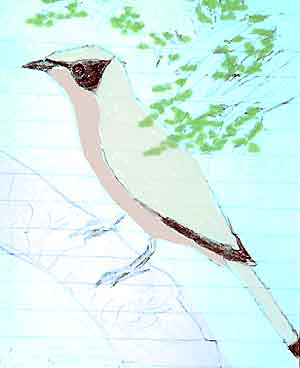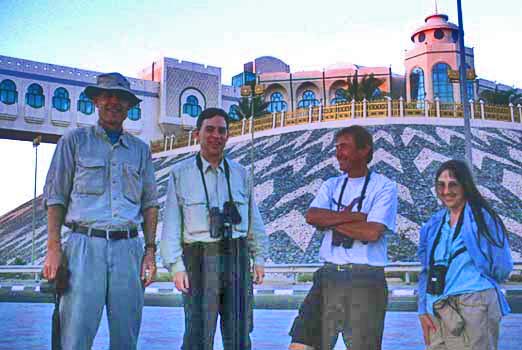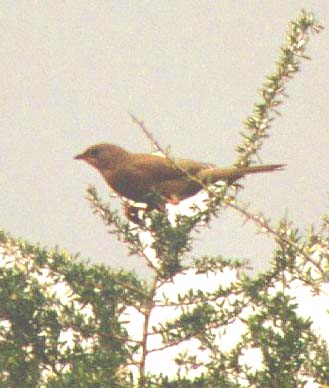
a web page by Don Roberson |
HYPOCOLIUS Hypocoliidae |
|
|
|
What makes the Hypocolius particularly difficult is political. Its breeding range is centered in Iraq & Iran, and east into Pakistan, and its primary wintering locations are in Saudi Arabia. These are all nations that have been very difficult to visit as western tourists. Birders searching for Hypocolius have been essentially restricted to looking for a few winter birds or spring migrants in Bahrain or the United Arab Emirates. When my friends and I sought it in 2001, we timed our U.A.E visit to the supposed spring migration peak in March. There had been only one known Hypocolius to winter in all of U.A.E. in 2001, and we probably saw it in the plantation described below. We ended up seeing three others in that orchard, so we must have had the first few spring migrants as well. |
|
"Look on my works, ye Mighty, and despair!" That is the way one feels standing beneath the facade of the great multi-million dollar Al Shati Hotel, north of Abu Dhabi in the United Arab Emirates (right). On the day of this photo it stood abandoned, sinking into the sand and structurally unsound. The lone and level sands of the Arabian desert stretch far way in front; the blue Persian Gulf stretches limpid and calm behind. Yet just to the right of this photo is a small orchard of mature Salvadora persicus trees, fruit-bearing in winter and spring and attractive to a wide assortment of birds. UPDATE: Colin Richardson now tells me that Al Shati Hotel was demolished in summer 2001. Just "two vast and trunkless legs of stone stand in the desert".... [ahem] |
|
 Our
experience with Hypocolius is that it is a very unobtrusive and
skittish species, often best located by its soft mellow mewing call. On
our visits to the Al Shati plantation in concert with small groups of
other birders, the Hypocolius always flushed before it could be spotted
perched or feeding on the ground (it is a fruit eater) and then flew
substantial distances to disappear into the foliage. It was only when
the three of us (Dan, Rita & I) were alone and moving oh-so-quietly
that Dan spotted the perched male sketched. Then we had leisurely views
for as long as we like, as the bird moved very slowly inside the canopy
of the small fruiting trees. I was particularly impressed with its
oversized feet (which I tried to capture in my poor way in the sketch)
and the strikingly angular shape of the black facial mask. There are
some words in the account by Cramp (1988) that mirror our experiences:
"Apparently becomes tame in close association with human habitat,
sitting amazingly tight in dense cover, but birds in natural habitat
shy, flying off when disturbed." The description of feeding behavior is
also apt: "Searches for food among trees, rarely descending to ground.
Noticeably deliberate in feeding movements when perched on bush,
stretching and balancing to reach berries with, at times, tail angled
well downwards... Will also fly down from perch like shrike Lanius,
apparently to take insects on ground, and recorded flying up to 3-4 m
to catch insect, then returning to perch." We didn't see the latter
behaviors but the deliberate movements within the tree were as
described. Our
experience with Hypocolius is that it is a very unobtrusive and
skittish species, often best located by its soft mellow mewing call. On
our visits to the Al Shati plantation in concert with small groups of
other birders, the Hypocolius always flushed before it could be spotted
perched or feeding on the ground (it is a fruit eater) and then flew
substantial distances to disappear into the foliage. It was only when
the three of us (Dan, Rita & I) were alone and moving oh-so-quietly
that Dan spotted the perched male sketched. Then we had leisurely views
for as long as we like, as the bird moved very slowly inside the canopy
of the small fruiting trees. I was particularly impressed with its
oversized feet (which I tried to capture in my poor way in the sketch)
and the strikingly angular shape of the black facial mask. There are
some words in the account by Cramp (1988) that mirror our experiences:
"Apparently becomes tame in close association with human habitat,
sitting amazingly tight in dense cover, but birds in natural habitat
shy, flying off when disturbed." The description of feeding behavior is
also apt: "Searches for food among trees, rarely descending to ground.
Noticeably deliberate in feeding movements when perched on bush,
stretching and balancing to reach berries with, at times, tail angled
well downwards... Will also fly down from perch like shrike Lanius,
apparently to take insects on ground, and recorded flying up to 3-4 m
to catch insect, then returning to perch." We didn't see the latter
behaviors but the deliberate movements within the tree were as
described. |
|
The Hypocolius had long been a mysterious bird taxonomically. Lowe (1947) pointed to Old World chat-like characters and thought it was a thrush. From the 1950s through 1980s, however, it was usually considered either a subfamily in the Waxwing [Bombycillidae] group, along with silky-flycatchers and the Palmchat (e.g., Cramp 1988), or a monotypic family that was closely related to those taxa. Clements (1991) didn't seem to know quite what to do. He put Hypocolius near bulbuls but had them separated the White-eyes [Zosteropidae]. It was not until a DNA sample was recovered from the sole of the feet of an old specimen that any biochemical analysis was performed. That analysis showed it was clearly within the bombycillid lineage, but has been evolving on its own for a very long time (Spellman et al. 2008). For us, Hypocolius was a prized and elusive species. To have our observations in such an unworldly spot was an added bonus. |
|
|
|
Update: Vladimir Dinets tells me of another spot for Hypocolius that can be reached in a friendly country to western tourists: "Hypocolius can be reliably seen in May-June in Badkhyz Zapovednik (Nature Preserve) in SE Turkmenistan. The place is remote and in a sensitive border area, but a trip can be arranged through Preserve administration. There are many other nice birds and many large mammals in Badkhyz. I also think it is a bulbul, but its Russian name means 'waxwing shrike'. The local Iomud Turkmen call it 'catbird'. This trip can be combined with a visit to nearby Repetek for ground-jays and other desert birds." It is also sometimes found in winter in the southwestern deserts of India. |
|
Photos: Martin Reid photographed the male Hypocolius Hypocolius ampelinus in Bahrain: the male was 6 March 1999 at the now-destroyed traditional roost at Magabah; the female was 4 March 1999 at the BDF Wadi, near Hamad Town. Scenic photo & sketch Ghantoot, Abu Dhabi emirate, United Arab Emirates, on 10 Mar 2001 © Don Roberson. Bird photos © Martin Reid, used with permission; all rights reserved. Bibliographic note: There is no "family book" good introduction to this family, with lots of natural history information, is in Porter & Aspinall (2005). Literature cited:
|
 The Hypocolius
(left, in a nice shot by Martin Reid) is an enigmatic and elusive bird.
Its relationships have been uncertain for decades. Sibley &
Ahlquist (1990) placed it next to bulbuls, suggesting it may be
related, but they had not evidence. More traditionally it was
considered a relative of the bombycillids — waxwings &
silky-flycatchers — and this relationship has just recently been
confirmed (Spellman et al. 2008). It has long been considered a
monotypic family, and among the hardest families in the world to
observe.
The Hypocolius
(left, in a nice shot by Martin Reid) is an enigmatic and elusive bird.
Its relationships have been uncertain for decades. Sibley &
Ahlquist (1990) placed it next to bulbuls, suggesting it may be
related, but they had not evidence. More traditionally it was
considered a relative of the bombycillids — waxwings &
silky-flycatchers — and this relationship has just recently been
confirmed (Spellman et al. 2008). It has long been considered a
monotypic family, and among the hardest families in the world to
observe.  Shelley wrote in his great poem Ozymandias:
Shelley wrote in his great poem Ozymandias:  Only the male Hypocolius has the black mask. Females are much less well-marked (left; another Martin Reid photo.
Only the male Hypocolius has the black mask. Females are much less well-marked (left; another Martin Reid photo.